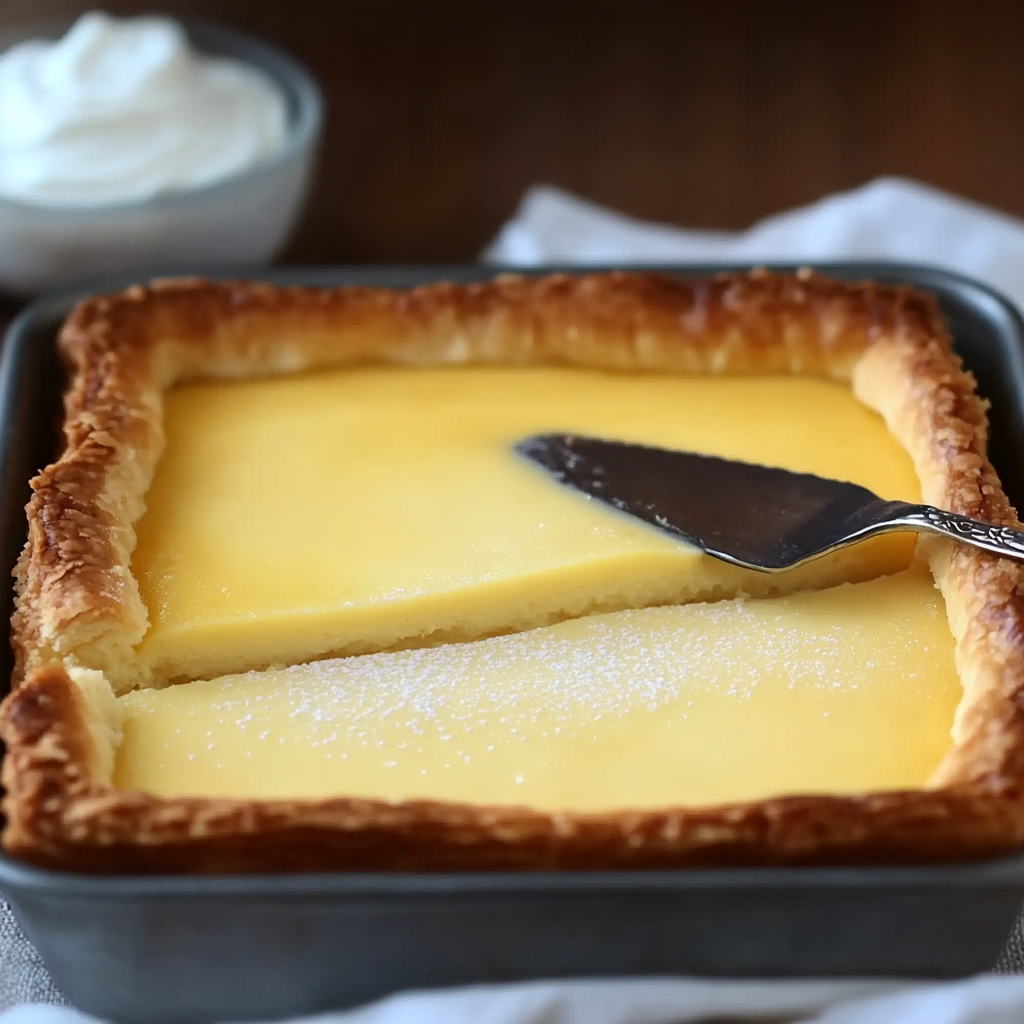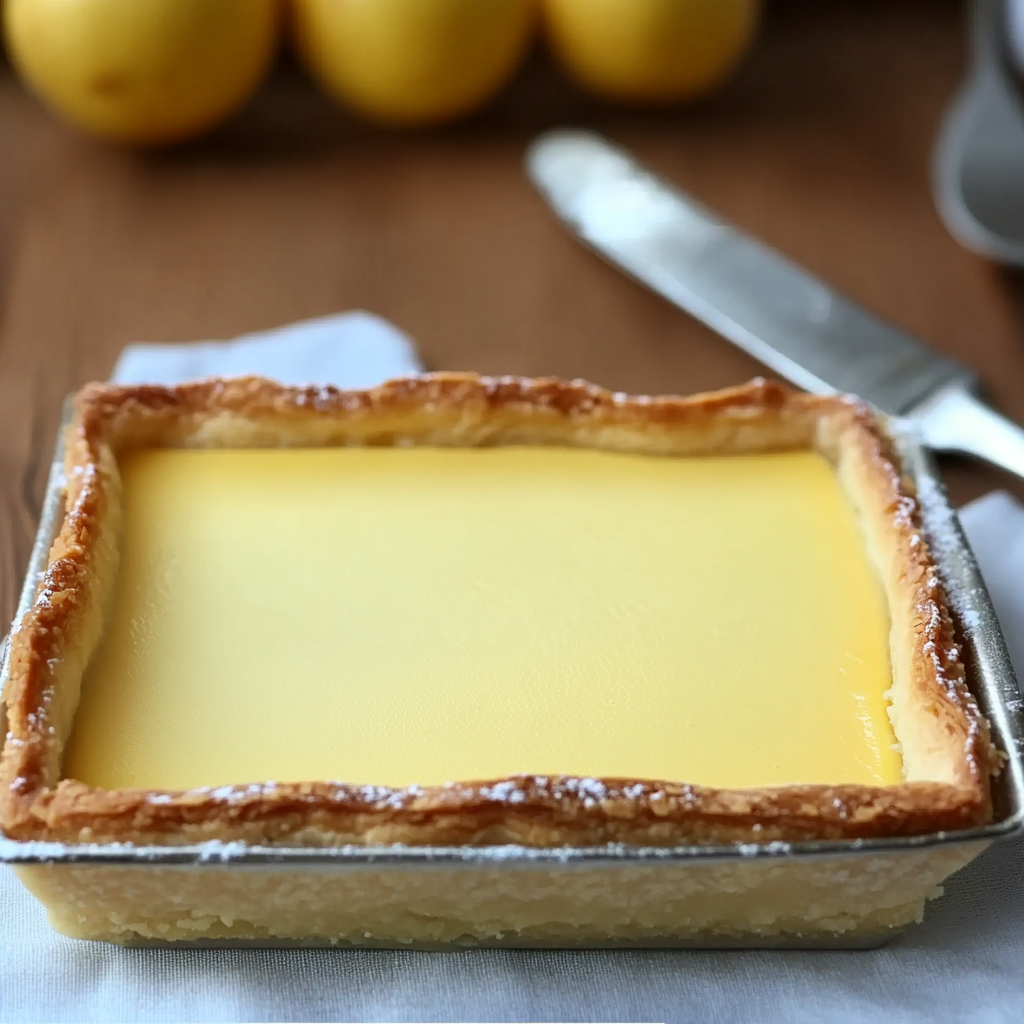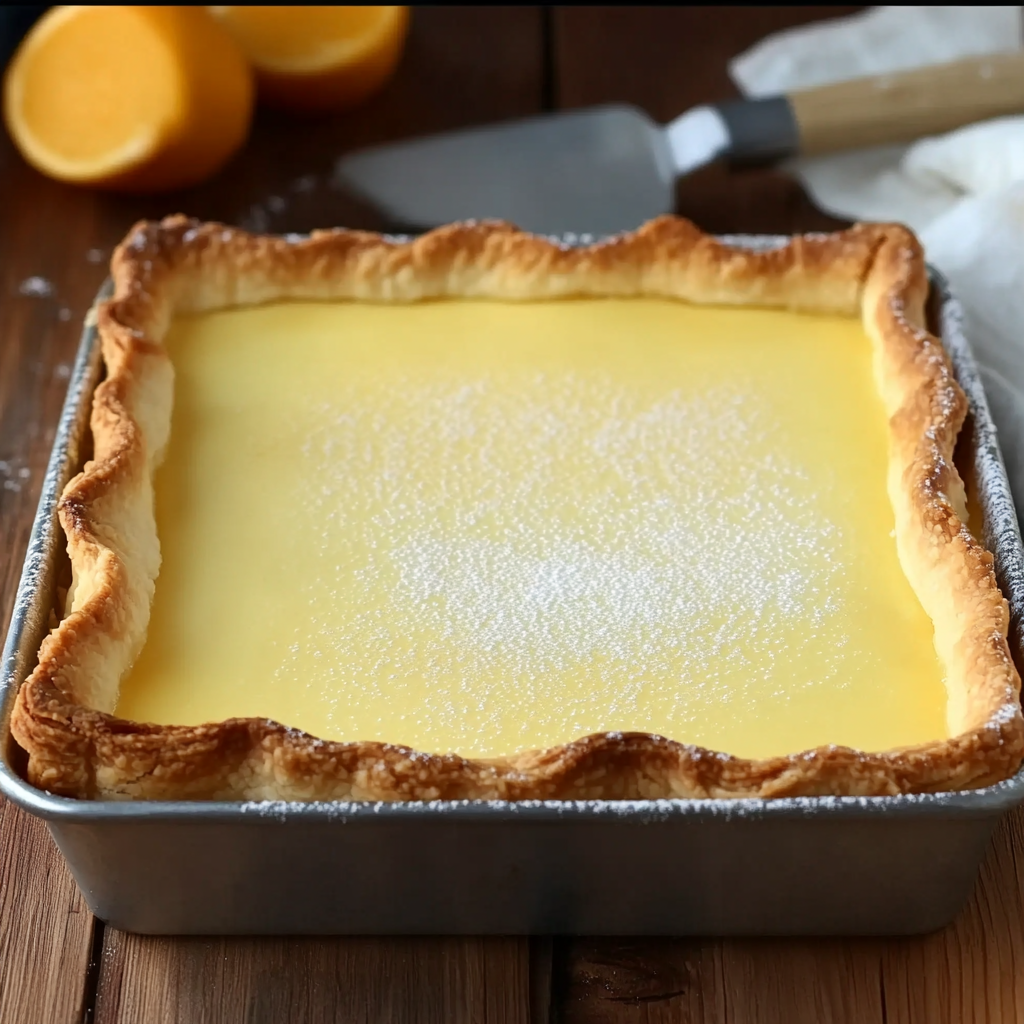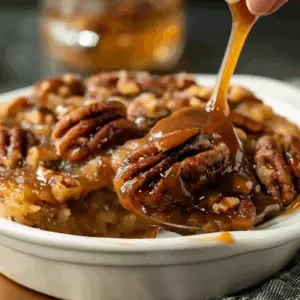The Beloved Italian Custard Cake
Torta Della Nonna, or Grandma Cake, is a timeless treasure from Italian cuisine that embodies warmth, tradition, and simplicity. This classic custard dessert combines a delicate shortcrust pastry with rich Italian custard (crema pasticcera), topped with a crunchy layer of pine nuts and a dusting of powdered sugar.
Loved across generations, it is a staple in family homes and trattorias alike. Originating from the heart of the Tuscany region, the dessert reflects the comforting embrace of home-cooked meals shared with loved ones.
Unlike trendy confections, Torta Della Nonna stands out for its nostalgic appeal and straightforward preparation. Whether discovered on a menu or in a Pinterest board of Italian dessert ideas, it evokes memories of family gatherings and Sunday lunches. It is more than a dessert—it’s an edible connection to Italy’s culinary heritage, where simple ingredients create something truly unforgettable.

The Story Behind Grandma Cake (Torta Della Nonna)
The origins of Torta Della Nonna are as rich as its custard filling. Despite its rustic name, which literally translates to “Grandmother’s Cake,” this dessert is believed to have been created in a professional kitchen rather than a family home. Many food historians trace its roots back to the Tuscany region, particularly Florence, where it was popularized in local trattorias during the 20th century.
According to culinary folklore, a chef was challenged to create a new dessert using simple pantry staples. He turned to ingredients like flour, butter, eggs, and milk—common in every Italian household. The result was a shortcrust tart filled with smooth crema pasticcera and topped with pine nuts. This new creation quickly became associated with traditional home baking, earning the endearing name Torta Della Nonna.
While today it is often featured in fine dining menus and elegant pastry cases, the cake’s charm lies in its humble beginnings. It became a symbol of Italian home cooking, where nonne (grandmothers) passed the recipe down through generations.
In many Italian families, making this dessert is a shared ritual. It reflects the values of love, patience, and heritage—just like you’ll find in countless Italian cuisine traditions. On platforms like Pinterest’s Grandma cake visuals, you can see how this nostalgic cake continues to inspire bakers around the world.
Its enduring popularity speaks to how timeless recipes can transcend trends while preserving their cultural significance.
Exploring the Flavors: Why Italian Custard Makes It Special
At the heart of Torta Della Nonna lies the rich, silky Italian custard known as crema pasticcera. This essential component is what elevates the dessert from a simple tart to a luxurious, nostalgic experience. Made from egg yolks, whole milk, sugar, lemon zest, and cornstarch, the custard is cooked slowly to develop a smooth, velvety texture and a subtly sweet, citrus-kissed flavor.
What sets crema pasticcera apart from standard custard is its intensity and thickness, designed to hold firm when baked. It brings a rich mouthfeel without being overly heavy, making each bite of the cake irresistibly balanced. You can learn more about its composition by exploring the Wikipedia page on pastry cream, which covers its French and Italian variations.
The use of lemon zest strips—a common element in Italian tart inspiration—adds brightness and depth, creating a perfect contrast to the buttery crust. A touch of vanilla extract rounds out the custard’s flavor, making it both comforting and refined.
Together, the shortcrust base and custard filling create a harmonious blend of textures and aromas that defines traditional Italian desserts. It’s no surprise this filling is at the center of many beloved recipes in Italy.
Pasta Frolla – The Foundation of the Dessert
A great Torta Della Nonna begins with the perfect base: pasta frolla, Italy’s answer to shortcrust pastry. This buttery, crumbly dough is what gives the dessert its structural integrity and delightful texture. Unlike other pastries, pasta frolla is rich and tender, thanks to a generous amount of butter, egg yolks, and sometimes lemon zest—which adds a subtle fragrance that complements the custard.
To make authentic pasta frolla, cold butter is cut into a mixture of all-purpose flour, powdered sugar, and a pinch of salt. The dough is gently brought together with egg yolks, a whole egg, and a splash of vanilla extract. After chilling for at least an hour, it becomes easy to roll and shape—essential for lining a tart pan without tearing. A closer look at shortcrust pastry techniques reveals how this dough differs from puff pastry or pâte sucrée.
Many Italian bakers, including those featured in custard tart recipes on Pinterest, rely on pasta frolla for everything from tarts to cookies. Its forgiving nature and excellent flavor make it a versatile tool in traditional Italian baking.
For Torta Della Nonna, the contrast between the crisp pastry and creamy filling is what makes each slice memorable.
Symbolism and Tradition in Italian Family Life
Torta Della Nonna is more than just a dessert—it’s a cultural symbol in Italy. Often made by grandmothers for Sunday dinners, holidays, or special family occasions, this custard-filled tart represents love, care, and the comfort of home-cooked meals. Every ingredient, from the pine nuts to the lemon zest, holds cultural significance rooted in Italian culinary values.
Pine nuts, for instance, are prized in Italian cooking and often used in both sweet and savory dishes. Their presence atop Torta Della Nonna not only adds crunch but also signifies celebration and abundance. Lemon, meanwhile, is a symbol of freshness and Mediterranean vitality—key to countless recipes across Italy.
Across Italian households, Torta Della Nonna is passed down through generations. The shared act of making it, especially with family members, becomes a ritual in itself. You’ll often find it as the finale to large family meals, symbolizing togetherness and tradition. On Pinterest boards celebrating baking with pine nuts, you’ll see how this simple decoration becomes a badge of authenticity.
Just like other staples of Italian cuisine, this tart tells a story of tradition, patience, and the irreplaceable bond between food and family in Italy.
Ingredients and Substitutions
To make an authentic Torta Della Nonna, you’ll need the following core ingredients:
-
For the pastry (pasta frolla):
-
All-purpose flour
-
Powdered sugar
-
Cold unsalted butter
-
Egg yolks + one whole egg
-
Baking powder
-
Lemon zest
-
Vanilla extract
-
Pinch of salt
-
-
For the custard (crema pasticcera):
-
Whole milk
-
Granulated sugar
-
Egg yolks
-
Cornstarch
-
Lemon zest (in strips)
-
Vanilla extract
-
-
Topping:
-
Pine nuts
-
Powdered sugar
-
For a dairy-free version, swap whole milk with almond or oat milk, and use margarine instead of butter.
Step-by-Step Instructions
Step-by-Step Instructions
1. Make the Pastry Dough
Start by mixing the dry ingredients: flour, powdered sugar, baking powder, and salt. Using your fingers or a pastry cutter, blend in the cold butter until the mixture resembles coarse crumbs.
Add egg yolks, the whole egg, vanilla extract, and lemon zest. Mix until the dough comes together. Wrap it in plastic and refrigerate for at least one hour to firm up.
2. Prepare the Custard
In a saucepan, heat the milk with the lemon zest strips just until it begins to simmer. Remove from heat and let it steep for 10 minutes. Discard the zest.
Meanwhile, whisk the egg yolks with sugar until pale, then add the cornstarch and whisk again. Slowly incorporate the warm milk while stirring. Return to the heat and cook, stirring constantly, until the custard thickens. Add vanilla extract and let cool with plastic wrap touching the surface to prevent a skin.
3. Assemble the Cake
Preheat oven to 350°F (175°C). Grease and flour a 9-inch tart pan.
Roll out two-thirds of the pasta frolla and line the pan. Trim any excess dough. Pour the cooled crema pasticcera into the crust.
Roll out the remaining dough and place it over the filling. Seal the edges and lightly prick the top with a fork. Sprinkle the top with pine nuts.
4. Bake and Finish
Bake for 35–40 minutes until golden. Let cool completely. Before serving, dust with powdered sugar. You can find more visual inspiration from this Pinterest custard tart board and similar Italian tart inspirations.
This traditional technique ensures every layer—buttery crust, silky custard, and toasted pine nuts—is executed to perfection.

Tips for Perfecting Torta Della Nonna at Home
Achieving the perfect Torta Della Nonna requires a few expert tips:
-
Chill the dough: Cold pasta frolla is easier to handle and bakes into a crisper crust.
-
Avoid overcooking the custard: Stir continuously and remove from heat as soon as it thickens to prevent curdling.
-
Use lemon zest strips, not grated zest: They steep better and give a cleaner citrus flavor.
-
Don’t skip the pine nuts: They add an essential crunch and a touch of elegance.
-
Dust with powdered sugar only after cooling: This prevents melting and ensures a clean, attractive finish.
For visual references, explore Torta Della Nonna inspiration boards or baking with pine nuts.
Master these details, and your Italian custard cake will look and taste like a family heirloom.
Variations of Torta Della Nonna
While the traditional Torta Della Nonna uses crema pasticcera, Italian bakers have created several delicious adaptations:
-
Chocolate Custard: Swap vanilla custard for a rich chocolate version by adding melted dark chocolate to the filling.
-
Ricotta Filling: In southern Italy, it’s common to use a ricotta and sugar filling, often enhanced with orange zest or mini chocolate chips.
-
Nut-Free Version: For allergy-friendly baking, the pine nuts can be omitted or replaced with slivered almonds or a light crumble topping.
-
Mini Tartlets: Create individual servings using muffin tins. These mini cakes are ideal for parties and look stunning on dessert trays.
Each variation brings a unique regional or modern twist to the classic. On Pinterest’s custard tart boards, you’ll find many contemporary versions that keep the spirit of the dessert alive while catering to modern tastes.
Experimenting with different fillings or shapes still preserves the essence of Italian home baking. Whether served as a large tart or tiny tartlets, Torta Della Nonna continues to evolve without losing its nostalgic charm.
Serving Suggestions and Storage
Torta Della Nonna is best served at room temperature or slightly chilled. The flavors meld beautifully after a few hours of resting. Before serving, dust generously with powdered sugar to highlight its rustic charm.
Pair it with espresso, cappuccino, or a sweet Italian dessert wine like Vin Santo.
Store leftovers in an airtight container in the refrigerator for up to 4 days. For longer storage, slices can be frozen and thawed before serving.
Whether as a weeknight treat or a Sunday finale, this Italian custard cake fits every occasion with grace and simplicity.

Frequently Asked Questions
What does Torta Della Nonna mean?
It translates to “Grandmother’s Cake” in Italian, honoring the nostalgic, home-baked nature of the dessert.
Can I make Torta Della Nonna ahead of time?
Yes, it actually tastes better when made a day ahead and refrigerated overnight.
What’s the difference between crema pasticcera and pastry cream?
They are nearly identical, but crema pasticcera often has citrus notes and a slightly firmer texture for baking. Learn more here.
Is Torta Della Nonna served warm or cold?
Traditionally, it is served chilled or at room temperature.
Can I freeze Torta Della Nonna?
Yes, wrap it tightly and freeze for up to 1 month. Thaw in the fridge before serving.
Italian Custard Desserts: The Story Behind Grandma Cake
A rich, traditional Italian custard cake made with a buttery shortcrust pastry, filled with creamy crema pasticcera, and topped with pine nuts and powdered sugar. Torta Della Nonna is a nostalgic dessert that captures the essence of Italian family gatherings.
- Author: Clara
Ingredients
For the pastry (pasta frolla):
- 2 ½ cups all-purpose flour
- ½ cup powdered sugar
- 1 tsp baking powder
- Pinch of salt
- 1 cup unsalted butter, cold and cut into cubes
- 2 egg yolks
- 1 whole egg
- 1 tsp vanilla extract
- Zest of 1 lemon
For the custard filling (crema pasticcera):
- 2 cups whole milk
- Zest of 1 lemon (in strips)
- 4 large egg yolks
- ½ cup granulated sugar
- ¼ cup cornstarch
- 1 tsp vanilla extract
For the topping:
- ⅓ cup pine nuts
- Powdered sugar for dusting
Instructions
To make the pastry dough, combine flour, powdered sugar, baking powder, and salt in a large bowl. Add the cold butter and mix with your fingertips or a pastry cutter until the mixture resembles coarse crumbs.
Add egg yolks, the whole egg, vanilla extract, and lemon zest. Mix until the dough comes together. Wrap in plastic wrap and refrigerate for at least 1 hour.
To prepare the custard filling, heat the milk in a saucepan with the lemon zest strips until just before boiling. Remove from heat and let it steep for 10 minutes, then remove the zest.
In a separate bowl, whisk the egg yolks with sugar until pale. Add cornstarch and mix until smooth. Slowly pour in the warm milk while whisking continuously.
Return the mixture to the saucepan and cook over medium heat, stirring constantly, until thickened. Remove from heat and stir in the vanilla extract. Transfer to a bowl, cover with plastic wrap directly on the surface, and let it cool completely.
Preheat the oven to 350°F (175°C). Grease and flour a 9-inch tart pan.
Roll out two-thirds of the chilled pastry and line the bottom and sides of the tart pan. Trim excess dough.
Fill the crust with the cooled custard. Roll out the remaining dough and place it on top, sealing the edges. Prick the top lightly with a fork.
Sprinkle the pine nuts evenly over the top. Bake for 35–40 minutes, or until golden brown.
Let the cake cool completely, then dust with powdered sugar before serving.
Notes
-
Always chill your dough for easy rolling and better texture.
-
Let the custard cool fully before filling the tart to avoid a soggy crust.
-
Use fresh lemon zest strips for the most aromatic flavor.
-
This dessert is even better the next day, as the flavors deepen overnight.
-
Store leftovers in the fridge and enjoy within 4 days.


